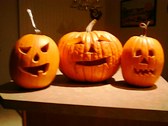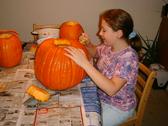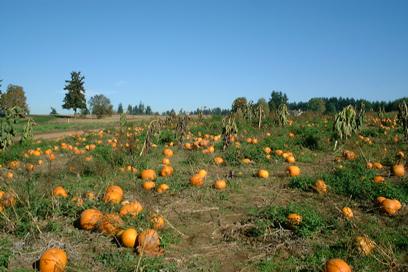|
|
Fun Facts & History
|
Below is an
abundance of fun information about pumpkins; History of the Jack O'Lantern,
the History of Pumpkin Carving, Pumpkin Facts, even some World
Record Pumpkins, along with some unique pumpkin photos. Enjoy! |
|
History
of the
Jack O'Lantern:

The Irish
brought the tradition of the Jack O'Lantern to America. But, the original
Jack O'Lantern was not a pumpkin. The Jack O'Lantern legend goes back
hundreds of years in Irish History. As the story goes, Stingy Jack was a
miserable, old drunk who liked to play tricks on everyone: family, friends,
his mother and even the Devil himself. One day, he tricked the Devil into
climbing up an apple tree. Once the Devil climbed up the apple tree, Stingy
Jack hurriedly placed crosses around the trunk of the tree. The Devil was
then unable to get down the tree. Stingy Jack made the Devil promise him not
to take his soul when he died. Once the devil promised not to take his soul,
Stingy Jack removed the crosses and let the Devil down.
Many years later, when Jack
finally died, he went to the pearly gates of Heaven and was told by Saint
Peter that he was too mean and too cruel and had led a miserable and
worthless life on earth. He was not allowed to enter heaven. He then went
down to Hell and the Devil. The Devil kept his promise and would not allow
him to enter Hell. Now Jack was scared and had nowhere to go but to wander
about forever in the darkness between heaven and hell. He asked the Devil
how he could leave as there was no light. The Devil tossed him an ember from
the flames of Hell to help him light his way. Jack placed the ember in a
hollowed out Turnip, one of his favorite foods which he always carried
around with him whenever he could steal one. For that day onward, Stingy
Jack roamed the earth without a resting place, lighting his way as he went
with his "Jack O'Lantern".
On all Hallow's eve, the
Irish hollowed out Turnips, rutabagas, gourds, potatoes and beets. They
placed a light in them to ward off evil spirits and keep Stingy Jack away.
These were the original Jack O'Lanterns. In the 1800's a couple of waves of
Irish. |
|
|
History of Pumpkin Carving:

Without a doubt the most recognizable
symbol of Halloween is a pumpkin carved into a jack-o-lantern. To
understand the origins of how pumpkin carving began and what it really
means we must first take a look at the holiday itself. How long has
Halloween been around? Have there always been pumpkins carved? Here are
some answers!
For
most of the general population it is known as Halloween and is a night
for dressing up, telling ghost stories, having spooky parties,
trick-or-treating and pumpkin carving. What most people don't know is
that Halloween is actually based on an ancient Celtic holiday known as
Samhain (pronounced "sow wan"), which means "summer's end". It was the
end of the Celtic year, starting at sundown on October 31st and going
through to sundown November 1st. It was a night to honor loved ones that
had passed on since the veil between their realm and ours is at it's
thinnest on that night.
Celebrated for centuries by the Celts
of old, Witches and many other nature based religions, it is the most
magical night of the year. It is the Witches' New Year, and the Last
Harvest. Although the religious significance of it has passed for the
general public, Halloween is a "magical" night for all!
On
this magical night, glowing jack-o-lanterns, carved from turnips or
gourds, were set on porches and in windows to welcome deceased loved
ones, but also to act as protection against malevolent spirits. Burning
lumps of coal were used inside as a source of light, later to be
replaced by candles. When European settlers, particularly the Irish,
arrived in America they found the native pumpkin to be larger, easier to
carve and seemed the perfect choice for jack-o-lanterns. Halloween
didn't really catch on big in this country until the late 1800's and has
been celebrated in so many ways ever since!
Pumpkins
are indigenous to the western hemisphere and were completely unknown in
Europe before the time of Columbus. In 1584, the French explorer Jacques
Cartier reported from the St. Lawrence region that he had found "gros
melons", which was translated into English as "ponpions," or pumpkins.
In fact, pumpkins have been grown in America for over 5,000 years.
Native Americans called pumpkins "isqoutm, or isquotersquash." Did you
know that pumpkins are not a vegetable - they are a fruit! Pumpkins,
like gourds, and other varieties of squash are all members of the
Cucurbitacae family, which also includes cucumbers, gherkins, and
melons. |
|
|
Did you know:
Did you
know that a pumpkin is really a squash?
Yes, it is! It's a member of
the Cucurbita family which includes squash and cucumbers.
Did you Know that pumpkins are grown all over the world?
Yes, in fact six
of the seven continents can grow pumpkins! Antarctica is the only
continent that they won't grow in. Pumpkins even grow in Alaska!
Did you know that the "pumpkin capital" of the world is
Morton, Illinois?
Yes, this self
proclaimed pumpkin capital is where you'll find the home of the Libby
corporation's pumpkin industry.
And did you know that the Irish brought this tradition of
pumpkin carving to America?
The tradition
originally started with the carving of turnips. When the Irish
immigrated to the U.S., they found pumpkins a plenty and they were much
easier to carve for their ancient holiday.

|
|
|
Pumpkin Fun
Facts:
● Pumpkins originated in
Central America.
● The name pumpkin
originated from "pepon" – the Greek word for "large melon."
● Pumpkins
contain potassium and Vitamin A.
● Pumpkins are
fruit.
● Pumpkin
flowers are edible.
● Pumpkin
seeds can be roasted as a snack.
● Pumpkins are
used to make soups, pies and breads.
● Pumpkins are
used for feed for animals.
● Eighty
percent of the pumpkin supply in the United States is available in
October.
● The largest
pumpkin pie ever made was over five feet in diameter and weighed over
350 pounds. It used 80 pounds of cooked pumpkin, 36 pounds of sugar, 12
dozen eggs and took six hours to bake.
● In early
colonial times, pumpkins were used as an ingredient for the crust of
pies, not the filling.
● Colonists
sliced off pumpkin tips; removed seeds and filled the insides with milk,
spices and honey. This was baked in hot ashes and is the origin of
pumpkin pie.
● Pumpkins were
once recommended for removing freckles and curing snake bites.
● The largest
"official" pumpkin ever grown weighed 1,340 pounds.
●
The largest "unofficial" pumpkin ever grown weighed 1'458 pounds, but
was not awarded due to damage.
● The
Connecticut field variety is the traditional American pumpkin.
● Pumpkins are
90 percent water.
● Eighty percent
of the pumpkins supply in the United States is available in October.
● Native
Americans flattened strips of pumpkins, dried them and made mats.
● Native
Americans called pumpkins "isqoutm, or
isquotersquash."
● Native
Americans used pumpkin seeds for food and medicine
 |
|
|